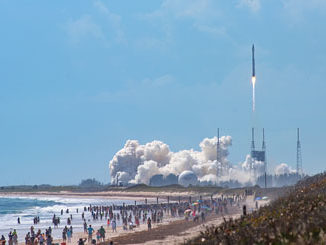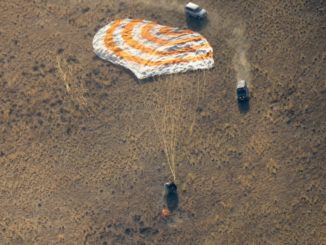
A Japanese HTV cargo freighter is ready for launch Wednesday with the last set of six lithium-ion batteries to upgrade the International Space Station’s solar power truss.
Japan’s ninth automated H-2 Transfer Vehicle, or HTV, is scheduled for liftoff from the Tanegashima Space Center in southern Japan at 1731 GMT (1:31 p.m. EDT) Wednesday aboard an H-2B rocket. Launch is scheduled for 2:31 a.m. Japan Standard Time on Thursday.
Standing 186 feet (56.6 meters) tall, the fully-assembled H-2B launcher is set to roll out to Launch Pad No. 2 at Tanegashima for the final countdown Wednesday, which include the loading of super-cold liquid hydrogen and liquid oxygen into both stages of the rocket.
The launch will mark the retirement of the H-2B rocket, built by Mitsubishi Heavy Industries. The H-2B is Japan’s most powerful rocket, and it has launched eight times since 2009 — all with HTV resupply missions for the International Space Station.
The H-2B rocket’s twin LE-7A first stage main engines will light in the final few seconds of the countdown, followed by ignition of four strap-on solid rocket boosters to propel the launcher off the pad with 2.5 million pounds of thrust.
After turning toward the southeast from Tanegashima over the Pacific Ocean, the orange, black and white rocket will drop its strap-on solid rocket boosters around two minutes into the flight. The H-2B’s nose fairing, which will shield the HTV supply ship in the early phases of the mission, will separate at around T+plus 3 minutes, 40 seconds.
The rocket’s first stage engines will shut down just shy of the six-minute mark on the mission, followed be stage separation seconds later. A single LE-5B engine on the second stage will ignite and ramp up to more than 30,000 pounds of thrust for a burn set to last more than eight minutes.
The second stage engine will accelerate the HTV supply ship into a preliminary orbit ranging nearly 200 miles above Earth. Deployment of the the HTV cargo craft is planned approximately 15 minutes after liftoff.
The H-2B and the less powerful H-2A rocket will be replaced by a new Japanese launcher named the H3. MHI and the Japan Aerospace Exploration Agency, or JAXA, are jointly developing the H3 rocket, which could be ready for an inaugural test flight before the end of 2020.
The ninth HTV supply ship is also the last in Japan’s series of barrel-shaped cargo freighters, but a next-generation spacecraft named the HTV-X is in development for a debut flight to the space station in 2022.
JAXA provides resupply services to the space station to help pay for Japan’s share of the the research lab’s operating costs.

The HTV spacecraft is nicknamed Kounotori, which is Japanese for “white stork,” and stretches around 33 feet (10 meters) long and 14 feet (4.4 meters) wide. The ninth HTV mission, or Kounotori 9, is packed with more than 13,600 pounds, or 6.2 metric tons, of cargo, supplies and experiments in its pressurized module and on its external payload bay, according to JAXA.
The unpressurized cargo consists of the six new lithium-ion batteries stowed on a pallet inside the HTV’s external payload compartment.
An on-time launch Wednesday would put the HTV on course to arrive at the International Space Station on Monday, May 25. The station’s Canadian-built robotic arm will capture the Japanese cargo freighter around 1215 GMT (8:15 a.m. EDT), two days before the launch of a SpaceX Crew Dragon spacecraft from the Kennedy Space Center in Florida on the first crewed orbital flight from U.S. soil since the retirement of the space shuttle in 2011.
Assuming it launches May 27, the Crew Dragon is scheduled to dock with the space station May 28.
The arrivals of the HTV and Crew Dragon in quick succession will make for a busy few days on the space station, which is operating with a limited crew of three, and just one NASA astronaut responsible for the U.S. segment of the orbiting outpost.
If bad weather or a technical problem keeps the HTV mission on the ground Wednesday, JAXA has a backup launch opportunity May 23, according to Gary Jordan, a NASA spokesperson.
Jordan said there’s nothing on the Crew Dragon mission — designated Demo-2, or DM-2 — that makes its launch schedule dependent on the HTV launching first.
“But any changes to HTV’s schedule would be assessed which may change target dates for other operations, including the DM-2 launch,” Jordan told Spaceflight Now.
Astronauts Doug Hurley and Bob Behnken will fly to the space station on the Demo-2 flight. Their stay at the station could last one-to-four months.
Hurley and Behnken will assist space station commander Chris Cassidy — the sole NASA crew member currently on the station — with experiments and spacewalks. Behnken and Cassidy are slated to perform several spacewalks as early as June to install the lithium-ion batteries to be delivered by the HTV mission.
Inside the station, Hurley will operate the research lab’s robotic arm to move Cassidy and Behnken around during the spacewalks. The batteries on the ninth HTV flight will be installed on the space station’s outboard S6 segment on the far starboard side of the craft’s 356-foot-long (108.5-meter) truss structure.
Once the battery spacewalks are complete, old nickel-hydrogen batteries replaced by the new lithium-ion units will be loaded into the HTV’s external cargo pallet and disposed during the cargo ship’s destructive re-entry at the end of its mission.
Email the author.
Follow Stephen Clark on Twitter: @StephenClark1.



